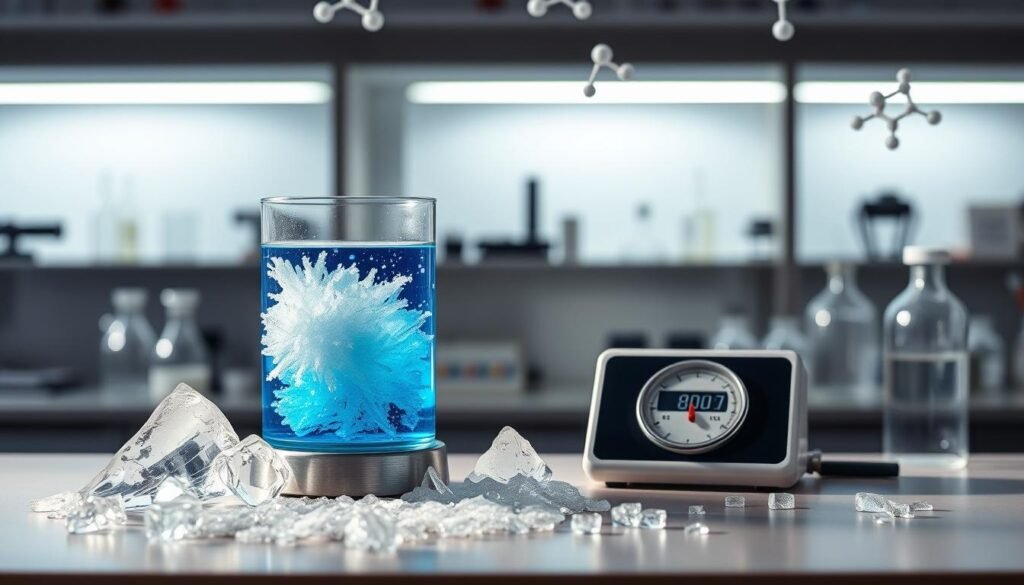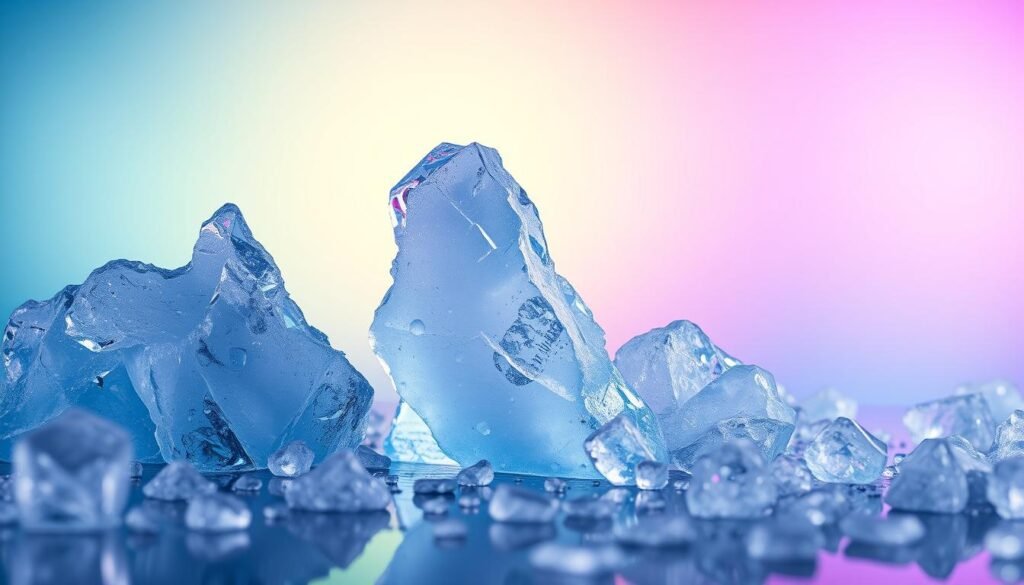Did you know the freezing point of water can drop to -21°C (-6°F) with road salt? This fact shows how freezing point depression works. It happens when solute molecules change the freezing process of solvents. This changes our understanding of solution chemistry.
When solutes mix into a solvent like water, they mix up the usual molecular order. This mix-up requires more energy for freezing. The drop in freezing point is a key detail. It shows how solute concentration affects a solvent’s freezing point.
The degree of freezing point depression is calculated with \(\Delta{T_f} = K_f \times m\). Here, \(K_f\) is the unique freezing-point depression constant of the solvent. The \(m\) is the solute’s molality. Every solvent shows different colligative properties. For example, water’s Kf is -1.86°C/m. Learning about freezing point depression helps us understand its practical uses and deeper scientific principles. To learn more, go here.
Key Takeaways
- Freezing point depression is key in solution chemistry.
- It occurs when solute molecules disrupt the solvent’s molecular order.
- The freezing point changes with the solute concentration.
- Each solvent has a unique freezing point depression constant (Kf).
- Its applications include road salting and antifreeze solutions.
Introduction to Freezing Point Depression
Freezing point depression happens when adding a solute lowers a solvent’s freezing point. This can be seen in many solutions and leads to key changes. The mixture of solute and solvent freezes at a lower point than the pure solvent alone.
This effect comes from colligative properties, which rely on solute concentration, not type. For example, adding salts like sodium chloride to water drops its freezing point. This is useful for keeping roads safe in icy conditions.
Understanding this concept helps improve antifreeze in cars and predict how natural water bodies behave. It gives researchers valuable information in chemistry and environmental science.
Understanding Colligative Properties
Colligative properties help us know how solutions change with solutes. They look at the solute particles’ number, not type. This matters most in weak solutions. There, adding solute changes the solvent’s physical traits a lot.
Definition of Colligative Properties
Colligative properties are changes seen when solutes mix with solvents. They cause noticeable shifts. Examples are:
- Freezing point depression
- Boiling point elevation
- Vapor pressure lowering
- Osmotic pressure
These properties focus on solute particles’ quantity. Adding a non-volatile solute, for example, makes the boiling point go up. It also makes the freezing point drop. This shows that solutions freeze at cooler temps than pure solvents.
Examples of Colligative Properties
Colligative properties appear in everyday life:
| Property | Description | Example |
|---|---|---|
| Freezing Point Depression | Lowering of a solution’s freezing point compared to a pure solvent. | Salting roads to prevent ice formation. |
| Boiling Point Elevation | Rise in a solution’s boiling point compared to a pure solvent. | Cooking pasta in salted water. |
| Vapor Pressure Lowering | Reduction of vapor pressure in a solution due to solute addition. | The effect of sugar in soft drinks. |
| Osmotic Pressure | Pressure required to prevent osmotic movement across a semipermeable membrane. | Kidney function in filtering blood. |

Knowing these effects lets us appreciate substance interactions better. Colligative properties shed light on things like cooking and food preservation. Boiling point, freezing point, and vapor pressure changes show how complex solutions are. They reveal more than just the parts they’re made of.
The Science Behind Freezing Point Depression
Freezing point depression looks at how solutes and solvents interact. When things like sugar or salt mix with water, they disrupt water’s hydrogen bonds. These bonds normally keep water molecules structured in ice. This means water needs to be colder to turn into ice when solutes are present.
How Mixing Affects Freezing Points
Adding solutes to a solvent changes the system’s chemical potential. As solute concentration goes up, the solvent molecules get more disturbed. This results in a bigger drop in freezing point. For example, basic vanilla ice cream, with sugar, has a freezing point drop of 0.68°C. In contrast, a simpler two-ingredient ice cream can have a reduction of 1.55°C.
The Role of Solute Concentration
The amount of solute has a big impact on freezing point depression. More solute means a larger effect on freezing point. Sugars or sugar alcohols like erythritol play a role in how products feel and taste. For instance, frozen fruits with sugar don’t freeze solid, affecting texture compared to just ice.
The formula ΔTF = – KF · m · i explains freezing point depression. KF is the freezer constant, m is the molality, and i is the van ‘t Hoff factor. This formula shows how solute concentration manages the freezing point.
These concepts are key in many fields, especially food science. They help create foods with the textures and flavors we enjoy.
Freezing Point Depression and Molality
Molality is key to understanding the decrease in the freezing point in solution chemistry. It measures the concentration of a solution. This is defined by the moles of solute per kilogram of solvent. This measure is crucial for figuring out how much the freezing point drops.
Defining Molality
In solution chemistry, we use the formula m = moles of solute / kilograms of solvent. This helps us see the effect of solutes on solvent properties, like freezing points. Higher molality means a bigger drop in freezing point.
Calculating Molality in Solutions
To calculate molality, you measure the moles of solute in solvent mass. Take mixing sodium chloride in water as an example. Doing this calculation helps us predict the freezing point drop. We use ΔTf = Kf × m to estimate this decrease. Here, Kf is the freezing-point depression constant.
| Solvent | Kf (°C/m) |
|---|---|
| Water | -1.86 |
| Acetic Acid | 3.9 |
| Benzene | 5.12 |
| Chloroform | 4.68 |
| Nitrobenzene | 8.1 |
Using ethylene glycol in a solution can greatly lower the freezing point. This helps cars stay cool. This way of calculating molality is useful in many fields, like environmental science and cooking. For more info, check out this resource.

Freezing Point Depression Constant (Kf)
The freezing point depression constant, or Kf, is vital in chemistry. It shows how solutes lower the freezing points of solvents. Each solvent has a unique Kf value. This reflects how they interact with solutes.
What is Kf?
Kf is a key constant that helps us understand the change in freezing point. It’s found using the formula \( \Delta T_f = K_f \times m \). Here, \( m \) stands for the solute’s molality. Knowing Kf is crucial for precise calculations in solution chemistry and cryoscopy. For example, water’s Kf value is 1.86°C kg/mol. This helps chemists study solute properties.
Common Kf Values for Various Solvents
Each solvent has a different Kf value. This affects their ability to lower freezing points with added solutes. Below is a list of common solvents and their Kf values:
| Solvent | Kf Value (°C kg/mol) |
|---|---|
| Water | 1.86 |
| Acetic Acid | 3.90 |
| Benzene | 5.12 |
| Carbon Tetrachloride | 30.0 |
| Ethyl Ether | 1.79 |
| Camphor | 40.0 |
Understanding solvent Kf values is crucial for chemists in experiments. It helps in tasks like checking substance purity and finding molecular weights. Kf is important not only in research but also in industries like food production and environmental science. For more details on freezing point depression, see this resource.

Factors Affecting Freezing Point Depression
The type of solute has a big impact on freezing point depression. Solute types matter a lot in how much they can lower the freezing point. Looking into both non-volatile and volatile solutes shows us more about this topic.
Type of Solute
Different solutes change the freezing point in various ways. Non-volatile solutes don’t create vapor pressure and lower the freezing point a lot. When they dissolve, they stop ice crystals from forming. This keeps the solution liquid even at colder temperatures. On the other hand, volatile solutes can turn into vapor. So, they don’t lower the freezing point as much.
Non-Volatile vs. Volatile Solutes
Non-volatile solutes, like sodium chloride (NaCl), are great at lowering freezing points. When NaCl dissolves in water, it breaks down into ions. This has a bigger effect on the freezing point than volatile solutes. That’s why non-volatile solutes are used on roads in winter to stop ice from forming.
To sum up, knowing the difference between volatile and non-volatile solutes helps predict freezing point depression. Non-volatile solutes are better at lowering the freezing point. They have special properties and interact with the solvent in unique ways.
| Type of Solute | Vapor Pressure | Effect on Freezing Point Depression |
|---|---|---|
| Non-Volatile Solutes | Does not exert vapor pressure | Significantly lowers freezing point |
| Volatile Solutes | Exerts vapor pressure | Less impact on freezing point depression |
Calculating Freezing Point Depression
Understanding the freezing point depression formula is crucial for various scientific calculations. This formula can be stated as ΔTf = Kf × m. Here, ΔTf is the change in freezing point, Kf represents the freezing point depression constant, and m is the molality of the solute. This shows how solute concentration influences a solvent’s freezing point.
The Freezing Point Depression Formula
The freezing point depression formula shows colder temperatures can be achieved by adding solutes. Kf values differ with the solvent, important for correct calculations. For water, Kf is 1.86 °C kg/mol. Each solute’s distinct characteristics significantly affect calculations. Like, sodium chloride (NaCl) has a van’t Hoff factor of about 2, demonstrating how dissociation affects freezing point adjustments.
Applying the Formula in Real Situations
Real-life uses of freezing point depression are widespread. Check out these examples:
- Road salting in winter uses sodium chloride or calcium chloride to lower water’s freezing point, avoiding ice.
- Antifreeze with ethylene glycol keeps vehicle radiators liquid in extreme cold. It’s crucial for safe driving.
- In ice cream making, sugar changes water’s freezing point so it stays scoopable even when cold.
These examples show the practical use of the freezing point depression formula in our lives. For instance, dissolving 31.65 grams of NaCl in 220.0 mL of water lowers the freezing point by 9.21 °C. This is key in managing icy streets during winter. For more on this, see this freezing point depression example problem.
| Scenario | Solute | Effect on Freezing Point |
|---|---|---|
| Road Salting | NaCl / CaCl2 | Prevents ice formation |
| Antifreeze | Ethylene Glycol | Prevents freezing in radiators |
| Ice Cream Production | Sugar | Keeps ice cream scoopable |
Freezing point depression is key in practical chemistry. It frequently comes up in calculations that affect safety and quality in our daily lives.
Real-World Applications of Freezing Point Depression
Freezing point depression is important in many areas. It helps preserve aquatic life and keeps roads safe during winter. This shows how useful the phenomenon is in our lives.
Impact on Aquatic Life
For aquatic creatures, freezing point depression is vital. In polar areas, sea ice pushes out salt as it freezes. This creates a brine that freezes at a lower temperature. It supports marine life in cold waters, including in areas where “Icy Finger of Death” brinicles can freeze other organisms. This process maintains a balance, letting aquatic life thrive in harsh conditions.
Uses in Road Salting and Ice Cream Making
In cities, freezing point depression is key in winter. Salting roads helps prevent ice build-up. This makes driving safer by reducing the risk of accidents on slippery roads.
In making ice cream, the concept also comes into play. Adding salt lowers the freezing point of ice around the mixture. This results in smoother, creamier ice cream. These examples show the practical impact of freezing point depression.
To learn more about the value of scientific understanding, check out this resource.